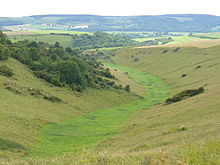- Dry valley
-
A dry valley is a valley found in either karst (limestone) or chalk terrain that no longer has a surface flow of water.
There are many examples of the latter along the North and South Downs in southern England. Notably the National Trust-owned Devil's Dyke near Brighton covers some 200 acres (0.81 km2) of downland scarp, and includes the deepest dry valley in the world - created when melting water eroded the chalk downland to the permafrost layer after the last ice age. The three-quarter mile long curved dry valley is around 700 feet (210 m) in height and attracts tourists with its views of Sussex, Hampshire and Kent.[citation needed]
Other examples include the Alkham Valley near Dover, and the Hartley Bottom and Fawkham valleys near Dartford in north Kent.[1]
There are two theories as to how they were made, the first that the water table was once much higher, while the other is that during the ice age the area had tundra like conditions. The normally permeable chalk would have been made impervious by permafrost, thus allowing rivers to flow without carving into it. Today these valleys don't have any rivers because water sinks through into the limestone and flows underground in caverns.[citation needed]
There are many examples in the Peak District and the Yorkshire Wolds. A notable example is the valley of the River Manifold which is dry, except in spate, from Wetton south for several miles.[citation needed]
See also
References
- ^ "Hartley-Kent: Geology and Scenery of Hartley, Longfield and surrounding area". www.hartley-kent.org.uk. http://www.hartley-kent.org.uk/history/geology.htm. Retrieved 2010-08-09.
External links
 Media related to Dry valleys at Wikimedia Commons
Media related to Dry valleys at Wikimedia Commons
This article relating to a topographical term is a stub. You can help Wikipedia by expanding it.

